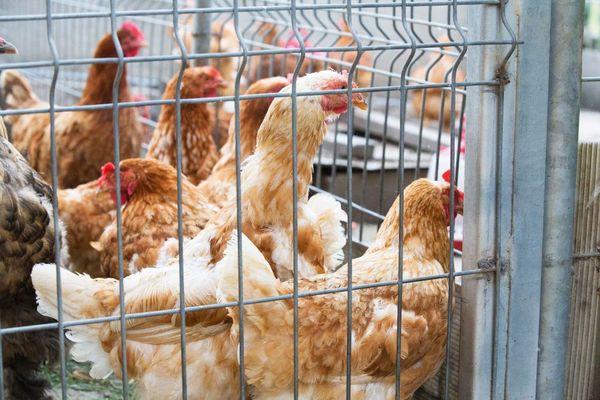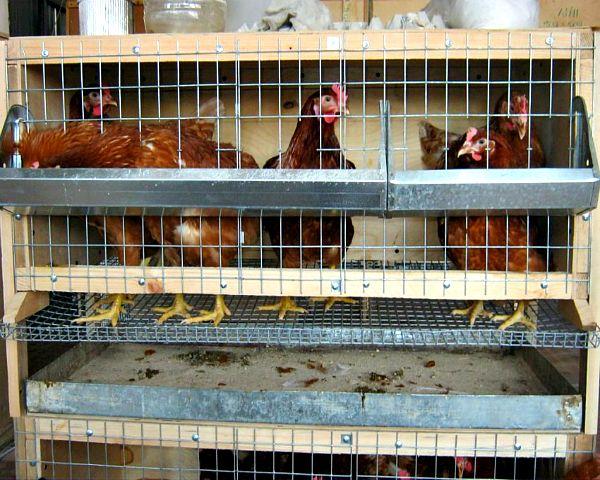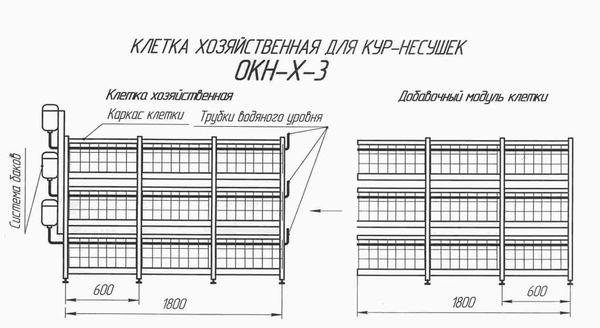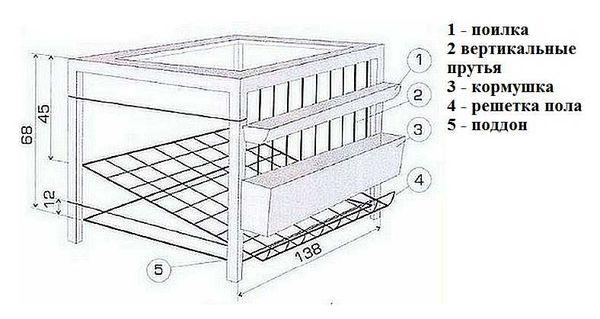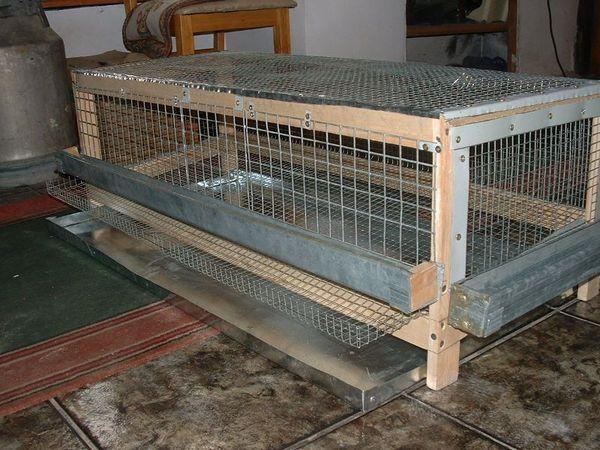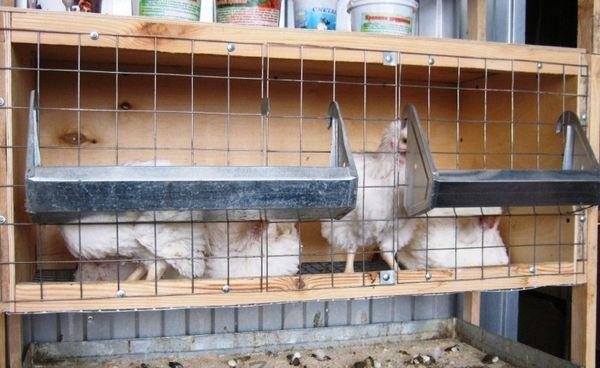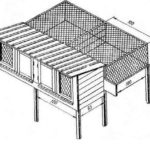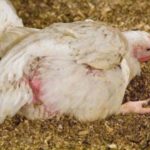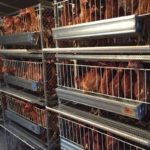In order for chickens to have good productivity, they must have high-quality care. One of the most important questions is how to properly make a cage for chickens. If done correctly, poultry will be kept in comfortable conditions. The laying house should be designed in such a way as to best take into account the characteristics of raising chickens.
The main pros and cons of cages for laying hens
Proponents of the idea that it is better to raise laying hens in a confined space of cages have their own arguments for this:
- With this method of keeping the birds, they are completely protected from attacks by predators.
- The degree of control over the health of the bird is much higher than in open space. Here you can immediately see a sick bird and take the necessary measures in this regard.
- Since contact with the outside world is limited, the likelihood of contracting infectious diseases is minimized.
- The cage has more suitable conditions to ensure long-term egg production.
- In confined spaces it is easy to collect eggs that have been laid. In open spaces, sometimes chickens hide them in secluded places where they are difficult to find.
- Due to limited mobility, birds living in cages eat less, which saves feed.
- The use of cages makes it possible to place more chickens on the farmer's available territory.
Some farmers are against keeping chickens in cages. They put forward the following arguments:
- A confined space limits the movement of hens and, as a result, reduces their productivity.
- The cages are located in a barn or chicken coop and use artificial light. As a result, weak ultraviolet irradiation leads to the formation of a small amount of vitamin D, which laying hens have to add to their food.
- Keeping them in cages does not give chickens the opportunity to eat natural food (grass, insects). To compensate for insufficient nutrition, special nutritional supplements are required.
- When several birds are together, infectious diseases spread among them at high speed.
On the one hand, when free-range, chickens have the opportunity to lead a healthier life, while increasing the number of problems for their owner. On the other hand, with careful and caring care, the disadvantages of keeping birds indoors can be compensated for.
For example, to do this you can do the following:
- Keep laying hens indoors only during the cold season, allowing them to spend time outside in the spring, summer and fall.
- Add fresh grass to their feeder.
- When keeping birds in cages, avoid overcrowding.
- Change the bedding often enough to make the birds feel more comfortable.
The better it will be laying hen care, the higher productivity can be expected from them.
Design requirements
It is necessary to provide feeders and drinkers for birds. It is believed that none of the walls of the structure should be blank. It is necessary to provide a microclimate that is best suited for chickens - the cages should be warm and dry.
Dimensions
The cage area should be calculated based on how many laying hens the owner has. For one bird it is necessary to provide 600 sq. cm. The total area must be such that all birds can be accommodated on it, taking into account compliance with the specified standard given for the egg-bearing breed. For egg-meat breeds, more space will be required - 800 sq. cm for each bird.
Strength
You need to take care of the strength of the floor. If it is weak, then over time it will begin to sag. It is necessary that the metal rods forming the grille be strong and the holes small. They must protect birds from predators, some of which (for example, ferrets or weasels) are able to crawl through a small hole.
Lighting
It is necessary to ensure that the light illuminates all cells evenly. There should be neither twilight nor too bright lighting. It will be useful to use a dimmer to ensure that the lights turn off and on smoothly, mimicking the natural cycle of day and night.
Availability of an egg collector
This piece is an inclined mesh with a stop running along the bottom side. When the hens lay their eggs, they roll down and lie along the edge, which is located where they can be easily collected. At the same time, the hen cannot reach them and accidentally damage them.
Types of cells
During the cold season, cages are kept indoors (in a chicken coop or barn). In summer, it is allowed to take chicken houses out into the open air. In this case, it is necessary to ensure that they are covered from above from possible rain. For this purpose, you can, for example, use slate or other similar material.
Housing for chickens can be made in different ways depending on the tasks set and the available financial capabilities. For example, the following options are possible:
- Cages with bedding provided. They have a solid floor on which a layer of straw or sawdust is placed.
- A design that includes an egg collector. In this case, the floor is made inclined so that the laid eggs lie compactly and in one part of the cage. The floor is made double. The bottom layer is made solid, and the top layer should be lattice. This type of cage helps keep the chicken house clean and dry.
In most cases, such designs are made for several chickens. They are usually designed for 7-10 birds. If we are talking about a large farm, then the capacity may be greater.
If there are a lot of birds on the farm, then the cages are arranged in a battery: in rows of several floors.
Required tools and materials
A cage can be made using various materials, but the most common is the use of galvanized metal mesh, which is fixed to a wooden or metal frame.
This is beneficial because it ensures good air exchange with the surrounding space and high-quality lighting if there are windows in the room.
To make a cage that will contain 4-5 laying hens, you need to prepare the following materials:
- A wooden block with a cross-section of 4x4 cm, 3 m long - 5 pcs required. 2x4 cm of the same length - 3 pcs.
- For the walls, floor and ceiling, you need a meter-wide mesh 3 m long. The cells should have a size from 15 × 15 mm to 25 × 25 mm.
- For the front wall you need to prepare a metal grid 1x1 m with cells 5x10 cm.
- You will need metal corners to create the frame.
- Two types of screws are needed: for fastening the frame and with large heads for installing the mesh.
- Galvanized sheet for making a pallet with a thickness of 1-1.5 mm.
Tools needed:
- hacksaw;
- screwdriver;
- square, level and tape measure;
- grinder for working with mesh and galvanized steel.
The dimensions of the cell in the case under consideration are 50 × 100 cm in length and width, 45 cm in height.
Manufacturing instructions
To make a cage with your own hands, you need to follow the steps described below sequentially. Initially, you need to draw up a diagram according to which the assembly will take place.
Frame, grille and trim
First you need to cut the wooden beam into pieces of the required length and make the frame of the cage from them.A thinner beam is used for the grate on which the cage should be installed.
The side and back walls must be made using a lattice.
Attach the mesh to the side and back walls, floor and ceiling.
Bottom, tray and legs
The bottom is made of fine mesh lattice. When installing, it is necessary to ensure a slope towards the front. The front edge of the grill should be folded up to prevent the eggs from rolling off.
Underneath it, about 10-15 cm lower, is a tray. It can be made of tin or be a horizontal wooden plane. Garbage and waste products of chickens fall onto the pallet. It is taken out, cleaned and then put back in place. It is generally recommended to clean the tray at least twice a week.
If the cage is too large, it will be difficult to clean the entire tray at once. In this case, you can make it consisting of several parts, each of which can be cleaned separately.
If the cage is to be taken outside, legs with wheels are attached to the bottom.
Front wall
A feeder is installed on the front wall. There should be holes here so that the hen can stick her head between the bars to reach the food. It is believed that the minimum size of the cells in this place should be 5x10 cm. The drinking bowl is located 10 cm higher.
On the front wall there is usually a door through which birds are placed in or taken out of the cage. With a single-tier arrangement, it can be made in the form of a folding roof.
Lighting
It is necessary to provide even, but not too bright lighting for birds. It will need to be turned off at night.
Ceiling
The ceiling is made of metal lattice. It is attached with self-tapping screws to the cage frame.
Roof
The material from which it is best to make the lid depends on whether the cage is intended to be taken outside during the warm season. If this is the case, then it is made of solid material to protect it from precipitation. It is recommended to provide a slope to ensure water flow.
If the chicken house remains indoors, then there is no need to make a lid for this purpose.
Care
It is recommended to clean the tray at least twice a week. The water in the drinking bowl must be kept clean at all times. In addition, the feeder and drinker must be cleaned and washed at least twice a week.

